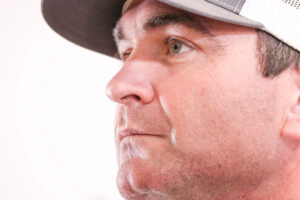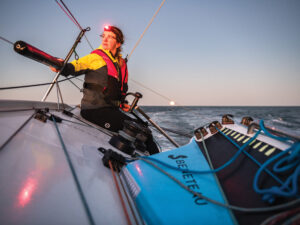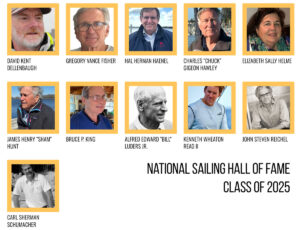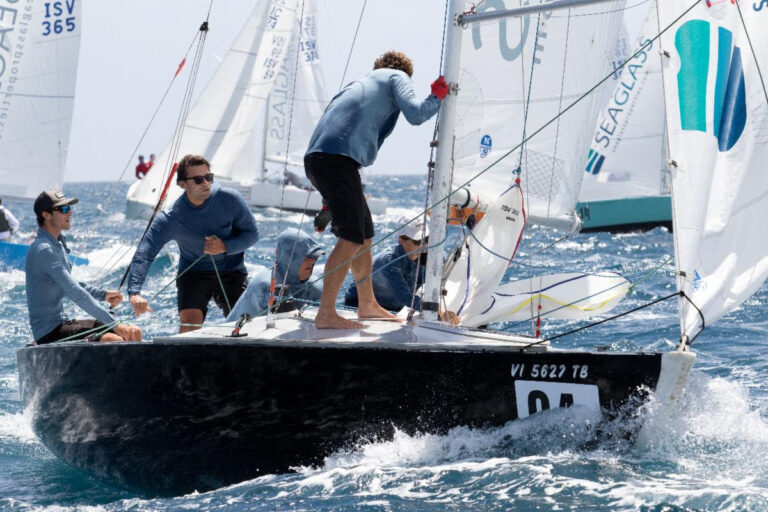
Jud Smith/Jobson
Performance on the water improves dramatically when an alert crew tunes the boat carefully, suggests clever tactics, and adjusts the sails for every subtle move of the rudder. Extraordinarily good crew are hard to find. But when you are lucky enough to have a superstar on board, you pay attention. Some years ago I was invited to race in Sailing World’s Hall of Fame Regatta. The event was to be sailed in Etchells, so I called the reigning world champion at the time, Dave Curtis, to see if he would crew for me. Dave said, “You don’t want me. You need Jud Smith. He will make you fast.” Taking Dave’s advice I called Jud and signed him on. Jud was 25 at the time. At the regatta several months later, we crossed the starting line of the first race on port tack ahead of the fleet. Nice! Sensing my nervousness, Jud said, “Ease the backstay off a quarter inch.” I eased the line one tooth of the cam cleat. Never taking his eyes off the sail, Jud then said, “That’s better now.” I thought to myself, if that small adjustment makes a difference, we’ll be in good shape. With Jud’s methodical guidance we went on to win the regatta. Recently I’ve tried to calculate the number of races I’ve sailed over the past 50 years. My best estimate is 5,000. The next step was to make a list of the best crew who have helped me. Topping that list is Jud. I’ve raced with him on many boats throughout the world, and every time we race, he lifts my game. There’s no finer boatspeed artist in America. Last fall I decided it was time to get back out on the racecourse after a two-year absence due to my battle with cancer. My partner in our Etchells, Gary Gilbert, couldn’t make the Annapolis YC Fall Regatta, but told me he’d lined up Rob Erda and Jud to sail with me. Naturally, I was excited. After a heartfelt welcome back by all the sailors in the fleet, we left the dock. It only took a few minutes before Jud said, “Do you mind if I retune your boat?” I had to smile; same old Jud. After 30 minutes of tweaking, he declared, “OK, we’re all set.” The problem, however, was that I wasn’t ready. At the start of the first race I misjudged the line at the port end and was forced to jibe behind the fleet. Jud and Rob didn’t seem fazed at all by my mistake. I was nervous but kept sailing. It soon became apparent that we had plenty of speed and my confidence built. At the first mark we were in sixth of 14 boats. On each leg we passed a boat and eventually placed second. In the next race I nailed the start, and we were launched. We went on to win the race and the regatta. And yes, I really missed being out there. Over the next week I started thinking about the qualities and techniques that make Jud so special. As I said earlier, when a master speaks, take note. Jud (now 48) was born into a sailing family. His father, Dave, won a gold medal in the 1960 Olympics crewing for George O’Day in a 5.5 Meter. Growing up, Jud credits his father, Robbie Doyle, Dave Curtis, and Jon Wales for being his mentors. More recently, he says he’s learned a lot from Dennis Conner. “Dennis’s strength is being a tinkerer,”says Jud. “He has lots of ideas. Many don’t work. But two out of 10 are good.” In 2004 Jud won the Etchells North Americans as skipper. When asked if he prefers to steer or crew, he smiles and says, “There’s no bad job on an Etchells. When I crew, it makes me a better skipper because I learn what works well. I’ve learned lots of things from many people on different boats.” He takes me through his routine: “First I make sure everything on the boat works well. Everything must be fitted out perfectly. Lines must run through blocks. When you ease a line, it can’t get hung up on anything. Make sure the lines have just the right amount of tension. Anything you can’t control with your fingertips should be changed.” “When things don’t work well,” Jud, the professor, continues, “your head is in the bilge.” On the racecourse he concentrates every second. He constantly experiments and compares speed with the competition. He makes one adjustment at a time. “I leave the dock with a base setting for the rig. Then I tune it gradually. It’s important to start from scratch because the tuning gets out of whack, week to week. “I look at the jib first. On most one-design boats the jib takes precedence. Once the jib-sheet lead and halyard are set, I work on the headstay sag.” Jud’s voice strengthens when discussing this technique: “Headstay tension is the single most important thing. I look if there’s enough curvature to power through waves in light wind. In a breeze, I work to flatten the sail.” He points out that fewer boats have running backstays today so other forces are critical in adjusting headstay sag. “I work with the standing backstay, rig tension, mast bend, mast-step position, and mainsheet trim.” Once the jib is set up, he continues with the main: “I look at the overall depth of the sail and ask if it’s too full or too flat. As the wind changes, I change the camber of the sail to increase power or reduce drag. Then I compare speed with other boats.” One of his on-the-water experiments is to test sails by swapping them with another boat. “When sails get old they might look OK,” Jud says, “but they can be tired and slow.” But he also cautions against using new sails for the first time in big regattas: “I recommend breaking them in during a tune-up regatta first.” When I ask what goes wrong with sails, he says, “Sails change. For example the luff tape shrinks. This can happen sitting in a trailer box. Heat and sun have a huge impact and can damage a sail.” Making a slow boat faster is a challenge. Racing in a match-race regatta once, the sails on our assigned boat were horribly misshaped. Jud’s solution was to use an inner forestay to bend the mast to improve the mainsail shape. The forestay made it difficult to tack the jib, but our extra speed gave us a big edge. No one else figured out the solution. During a race, Jud is calm and low key. He makes suggestions in a monotone, but has a clear, deep-seated desire to excel. He has considerable patience, and just keeps plugging away, eventually finding a way to prevail. Jud has raced all sizes of boats and says he likes small keelboats best. “With a small crew, everyone is hands on.” At the other end of the spectrum, Jud trimmed the mainsail for Conner during the 1995 America’s Cup trials. “The ACC boats are quirky,” he says. “They require lots of tuning. They are very hard to set up. They are heavy boats and need lots of power. They are glamorous, interesting, impressive, and exotic. Being on an America’s Cup crew is like being in the Marines or on a professional football team. But after one campaign I decided there were a lot of other things I wanted to do.” Jud and his wife Cindy have two daughters, Derby, age 16, and Lindsay, 15. Both girls grew up sailing Optis and now race 420s on the Marblehead High School sailing team. Jud occasionally coaches. “When they let me,” he says with a laugh. He now races at least eight days per month. He gives frequent clinics, mostly for Etchells sailors, bringing his boatspeed mastery to anyone who’ll pay attention.









